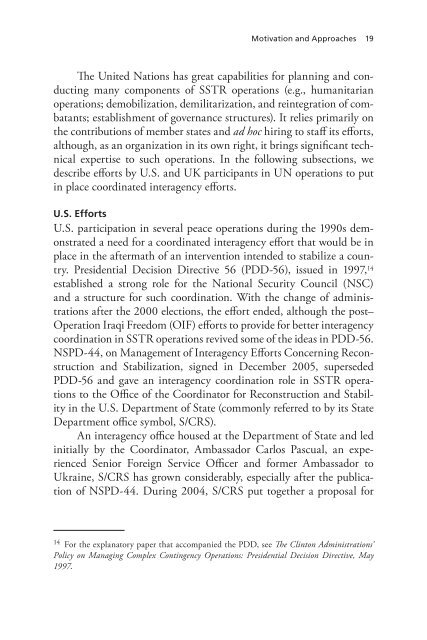Stabilization and Reconstruction Staffing - RAND Corporation
Stabilization and Reconstruction Staffing - RAND Corporation
Stabilization and Reconstruction Staffing - RAND Corporation
You also want an ePaper? Increase the reach of your titles
YUMPU automatically turns print PDFs into web optimized ePapers that Google loves.
Motivation <strong>and</strong> Approaches 19The United Nations has great capabilities for planning <strong>and</strong> conductingmany components of SSTR operations (e.g., humanitarianoperations; demobilization, demilitarization, <strong>and</strong> reintegration of combatants;establishment of governance structures). It relies primarily onthe contributions of member states <strong>and</strong> ad hoc hiring to staff its efforts,although, as an organization in its own right, it brings significant technicalexpertise to such operations. In the following subsections, wedescribe efforts by U.S. <strong>and</strong> UK participants in UN operations to putin place coordinated interagency efforts.U.S. EffortsU.S. participation in several peace operations during the 1990s demonstrateda need for a coordinated interagency effort that would be inplace in the aftermath of an intervention intended to stabilize a country.Presidential Decision Directive 56 (PDD-56), issued in 1997, 14established a strong role for the National Security Council (NSC)<strong>and</strong> a structure for such coordination. With the change of administrationsafter the 2000 elections, the effort ended, although the post–Operation Iraqi Freedom (OIF) efforts to provide for better interagencycoordination in SSTR operations revived some of the ideas in PDD-56.NSPD-44, on Management of Interagency Efforts Concerning <strong>Reconstruction</strong><strong>and</strong> <strong>Stabilization</strong>, signed in December 2005, supersededPDD-56 <strong>and</strong> gave an interagency coordination role in SSTR operationsto the Office of the Coordinator for <strong>Reconstruction</strong> <strong>and</strong> Stabilityin the U.S. Department of State (commonly referred to by its StateDepartment office symbol, S/CRS).An interagency office housed at the Department of State <strong>and</strong> ledinitially by the Coordinator, Ambassador Carlos Pascual, an experiencedSenior Foreign Service Officer <strong>and</strong> former Ambassador toUkraine, S/CRS has grown considerably, especially after the publicationof NSPD-44. During 2004, S/CRS put together a proposal for14 For the explanatory paper that accompanied the PDD, see The Clinton Administrations’Policy on Managing Complex Contingency Operations: Presidential Decision Directive, May1997.
















